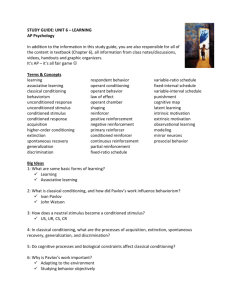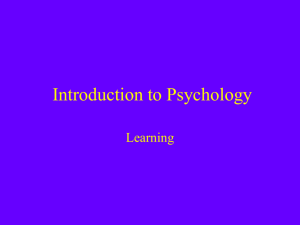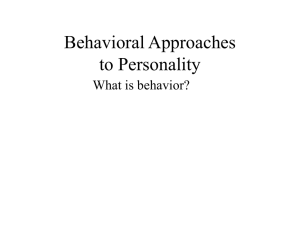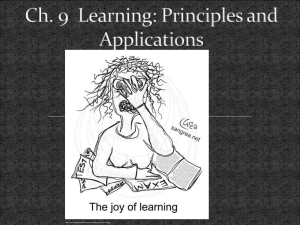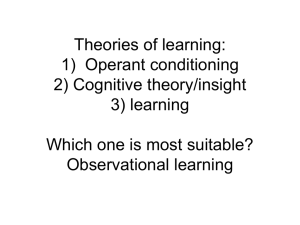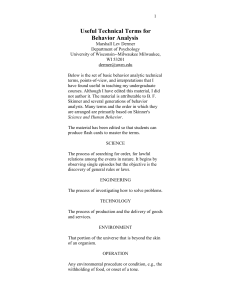Learning
advertisement
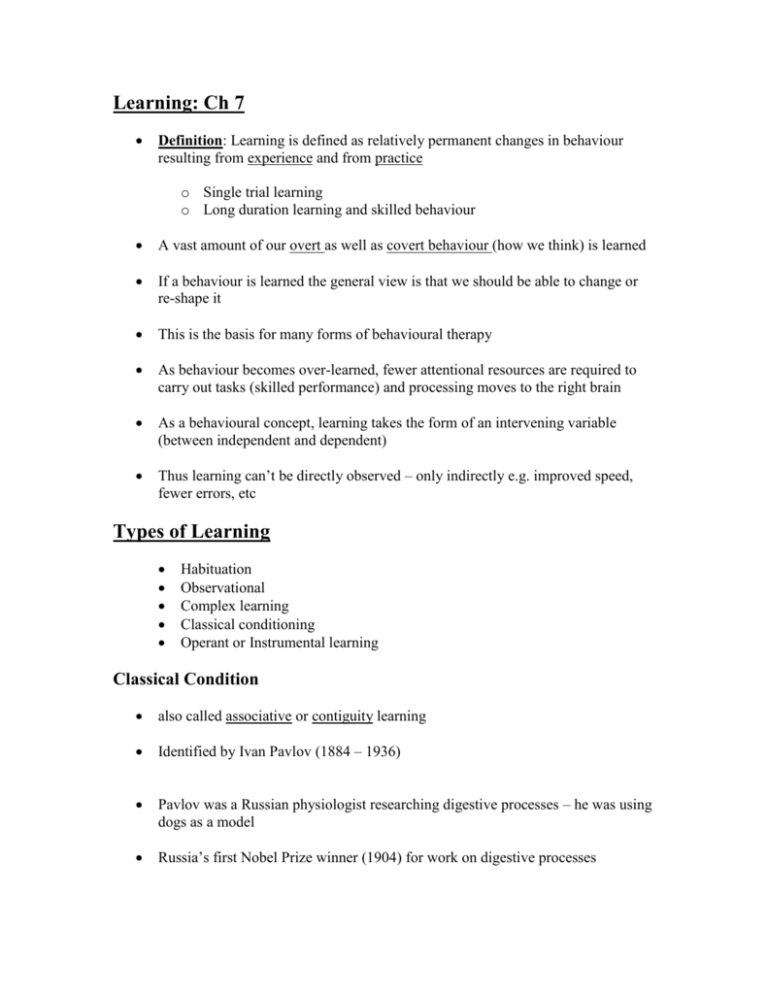
Learning: Ch 7 Definition: Learning is defined as relatively permanent changes in behaviour resulting from experience and from practice o Single trial learning o Long duration learning and skilled behaviour A vast amount of our overt as well as covert behaviour (how we think) is learned If a behaviour is learned the general view is that we should be able to change or re-shape it This is the basis for many forms of behavioural therapy As behaviour becomes over-learned, fewer attentional resources are required to carry out tasks (skilled performance) and processing moves to the right brain As a behavioural concept, learning takes the form of an intervening variable (between independent and dependent) Thus learning can’t be directly observed – only indirectly e.g. improved speed, fewer errors, etc Types of Learning Habituation Observational Complex learning Classical conditioning Operant or Instrumental learning Classical Condition also called associative or contiguity learning Identified by Ivan Pavlov (1884 – 1936) Pavlov was a Russian physiologist researching digestive processes – he was using dogs as a model Russia’s first Nobel Prize winner (1904) for work on digestive processes Classical conditioning involves: The autonomic nervous system (sympathetic and parasympathetic) and its’ corresponding involuntary smooth muscles Classical conditioning requires: • A stimulus for which the meaning is innately understood (e.g. food, water, warmth, pleasure, pain) unconditioned stimulus (UCS) • A second contiguous neutral stimulus (NS) which initially has no specific meaning (e.g. a bell) but which has the capacity to invoke an orienting type response • As the UCS and NS are presented contiguously (close together in time) on successive occasions, the NS becomes a predictor of the UCS • Once the NS is interpreted by an organism as reliably predicting the UCS, the NS is raised to the status of a conditioned stimulus (CS) • Thus classical conditioning has occurred when a previously meaningless NS has become a CS (that is a stimulus now regulating a behavioural response) • Note: to obtain classical conditioning, a NS must precede an UCS by at least 0.5 seconds • Acquisition: UCS and CS pairings create stimulus associations • Extinction: lack of UCS and CS pairings cause associations to disappear • Spontaneous Recovery: reappearance of learning after extinction • Note: the general concepts (acquisition, extinction) also apply to operant learning Operant Learning • Operant or Instrumental learning was first identified in North America in the early 1900’s • Based on the work of Watson and Thorndike • Thorndike’s Law of Effect stated that rewarded behaviour is more likely to reoccur • BF Skinner (1904 – 1990) Physiological mechanisms: • Skeletal and voluntary striated muscles • CNS and PNS • The overall framework for learning is response / reinforcement (R-R) • Distinct from classical conditioning with its’ stimulus / response (S-R) framework Terminology: • Shaping: Learning in gradual steps • Reinforcement: a stimulus event that increases the likelihood of a response • Primary reinforcer: innate reinforces e.g. food, water, warmth, pleasure • Secondary reinforcer: learned reinforcers e.g. money, praise, good grades, status • Positive reinforcement: increasing the likelihood of a response by administering a pleasant stimulus (e.g. if you get good grades I will buy you a new car) • Negative reinforcement: increasing the likelihood of a response by removing an adverse stimulus (e.g. if you get good grades you can stay out later on Friday and Saturday nights) • Punishment: decreasing the likelihood of response by administering an adverse stimulus (e.g. if you obtain poor grades you will be grounded for a semester) Schedules of reinforcement: • These refer to the pattern of responding required for reinforcement and are of 2 general types: 1) Ratio schedules: reinforcement is contingent on the number of responses generated since the last reinforcer 2) Interval schedules: reinforcement is contingent on the time that has elapsed since the last reinforcer • Ratio and Interval schedules can be further categorized as fixed or variable 1) Fixed: reinforcement is contingent on a fixed number of responses or a fixed amount of time since the last reinforcer 2) variable: reinforcement is contingent on a variable number of responses or a variable amount of time since the last reinforcer Four basic schedules of reinforcement: Fixed Variable Ratio 1) Fixed Ratio 2) Variable Ratio Interval 3) Fixed Interval 4) Variable Ratio Two Process Learning: Learning where a classically conditioned response controls or moderates an operant or instrument al response • The onset of a classically conditioned fear response to a buzzer (CS) motivates an avoidance response (operant bar pressing) • The subsequent termination of the buzzer and shock (UCS) reinforces future avoidance response (operant) Learned Helplessness: The failure to avoid or escape from an unpleasant or aversive stimulus that occurs as a result of previous exposure to unavoidable painful stimuli is referred to as learned helplessness. Learned helplessness, which has been demonstrated in both animals and humans, is associated with many of the symptoms characteristic of depression Stimulus Generalization and Discrimination:





